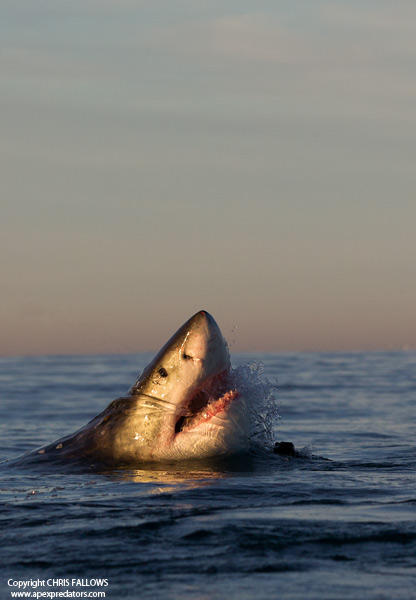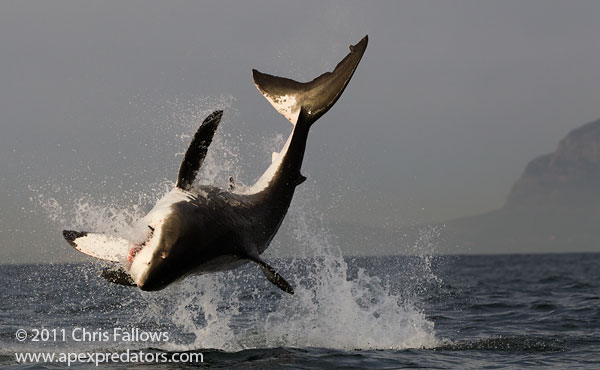‘Predation! Nine o’clock! 100 metres!’ is not a phrase you will hear shouted on your average day in life but then a day at sea with Apex Shark Expeditions isn’t your average day. Every trip is unique, each guest and each crew member full of excitement and anticipation as we depart for Seal Island before sunrise; hoping to see the magnificent Great White Shark and other wildlife of False Bay in South Africa. As the sun rises over the mountains surrounding us, as the waters turn golden and the nautical miles skip by we hold on tight and prepare for the adventure of a lifetime.

Seal Island is the premier location to observe Great White Sharks and their natural hunting behaviour upon Cape Fur Seals. It is Africa’s largest island-bound seal colony, with 64,000 Cape Fur Seals and lies within the waters of False Bay in the Western Cape. False Bay hosts an incredible array of wildlife including the seals, a number of bird species, dolphin and whale species and the sharks that this bay is renowned for. It truly is a marine safari. For those that have been on safari, you will know how rare it is to see a predatory event. That we observe such natural predations regularly at Seal Island is what sets this area apart from other locations worldwide.
As we arrive at Seal Island you can’t help but be overcome by the beauty of this location, of the sheer number of seals and the bird species resident on this small rocky island. The seals leave the island in their groups as they head out of False Bay to feed and we observe these groups carefully for signs that the sharks are in hunting mode. The white shark is an ambush predator, hunts from the depths below the groups of seals and launches itself out of the water in pursuit of its prey. They have earned the name ‘flying sharks’ from this unique hunting behaviour that is particularly prevalent at Seal Island. You can literally feel the tension on the boat as both crew and guests scan the horizon eagerly, watching the groups of seals like hawks in the hope of seeing a white shark breaching from the water.

‘Predation! Nine o’clock! 100 metres!’ A white shark leaps from the water in pursuit of a seal from the group and thanks to our careful observation we have witnessed this spectacle in motion. We use a clock system onboard to denote the location of a predation event and all guests were lucky enough to witness the shark literally flying through the air. As quickly as it occurred, as quickly the predation event is over and flocks of Cape Kelp Gulls congregate at the site of the kill. We watch the shark swimming on the surface before it disappears back to the depths. To see your first white shark in the ocean is incredible, to see your first white shark air-borne goes way beyond your wildest dreams. The agility of these sharks and their sheer size is awe inspiring. It is fair to say that witnessing such predation events leaves us all speechless. There are only approximately 3000 white sharks left in the wild and it is a privilege to see them and their natural behaviour. As with any safari, our guests know we cannot guarantee these events and they were delighted to have been a part of this moment. On some days we do not see the natural predation events; on others we are fortunate enough to witness anything from one to more than forty events.
‘Blink and you will miss it guys. Do NOT take your eyes off the decoy’ is a phrase I repeat daily for our guests as we tow our decoy seal behind the boat in the hope of attracting a white shark to the seal and witnessing the shark leaping. Our decoy seal is made of neoprene, it is harmless to the sharks and we are careful not to tow for too long or too often as we do not want to waste the sharks’ hunting energy. Whilst the tow has no guarantee of being successful, it can be the perfect opportunity to capture the flying sharks on film and a hush descends upon the entire boat as we begin. It is the one time in the day you can hear a pin drop as everyone concentrates silently. We are all watching the decoy, cameras bleep quietly as each autofocus adjusts and arms begin to ache as we motor along slowly waiting for that special moment. Each breach is as unique as each shark and they vary from slow motion vertical lunges to cart wheeling through the air as the shark twists and turns on a dime. Today we had success and the boat goes wild as the shark leaps for the decoy. The guests’ shouts and whoops adding to the buzz as we compare what we saw and check our cameras to see who captured the moment.
As the sun lifts itself higher in the sky and our guests chat happily whilst getting to know each other, we set anchor near the island and begin the process of attracting a shark to our vessel. This part of the morning is when we can observe the sharks behaving in a more relaxed manner as they are no longer in hunting mode. The boat affords excellent viewing opportunities to watch from the surface and we also offer cage diving for those that wish to see the white shark at eye level. Whilst many of our guests wish to go cage diving, the views from the top deck of our vessel are superb and it is by no means necessary to dive in order to have a fantastic view of the sharks and their behaviours.
At no point do we feed the sharks and our bait is used purely as an attractant. We also have a stationary decoy seal that we place on the surface, which is often of more interest to the sharks than the bait itself. Our first shark arrives after a patient wait; this is the time when I find the guests’ opinions of white sharks really changes as they clamour to the boat side to see our visitor. They observe the shark moving slowly, gracefully through the water as it moves in towards our bait and decoy. The shark is curious and demonstrates the ease with which it can approach, investigate and bank away into the depths so effortlessly. This is not the hunting behaviour we observed earlier, this is a shark calmly investigating novel objects in its environment as it goes about its business.
If a shark stays with us for a period of time you can get to know its personality and observe its unique markings. It is these moments that allow us to identify individuals each season and observe them year on year as they grow into maturity. Each shark behaves differently around the boat and it is clear they have very distinct personalities. We have smaller sharks that are playful around the bait, nipping as we pull the bait gently away and returning to chase the bait repeatedly. We have larger sharks that are slower, more relaxed and disinterested in the bait but keen to investigate the decoy seal and move alongside the boat. They are as unique as you and I in their behaviours and a joy to watch.

For those that wish to go cage diving now is the time and it is fair to say many guests are nervous at this point. The shark is after all a predator, we have been brought up to fear it and we are entering into its own environment. There is nothing to fear though; the crew work hard to ensure the comfort and safety of our guests and we ensure it is a relaxed and enjoyable experience. I have witnessed guests laughing and giggling through their snorkels as the shark passes in-front of them and exclamations of how huge the sharks are at eye level. The divers raise their heads above the surface to excitedly share the news with the rest of the guests that they saw the shark pass by. We operate our diving at the surface using mask and snorkel and you do not need to be a qualified diver to cage dive with us. The advantage of being at the surface with your head above water is that we can shout when to duck down and in which direction to look to ensure you see the shark. This surface communication gives the very best opportunity to ensure a successful encounter.
As the diving comes to a close later in the morning and our guests are relaxing with some food and drinks onboard, our trip is by no means over. Before heading back to port we continue on our safari around Seal Island to observe the behaviours of the Cape Fur Seals and other wildlife on the island. Whilst this island is home to many seals, it is also home to three different species of cormorant, a colony of South African Penguins and the Cape Kelp Gulls. It is a wonderful experience watching the young seals playing in the waters close to the north eastern part of the island as the females bask in the sunshine. The noise as they communicate is quite something as we pass by.
As we leave Seal Island and the sharks behind for another day, we look for other wildlife within the bay such as whales and dolphin. Common dolphin are especially common in False Bay in April but can be seen year round on approximately 20% of our trips. These beautifully patterned dolphins are a delight as they swim alongside us and ride our bow wave.
Back ashore and it is time for our guests to enjoy some hot drinks as they swap email details for those ever important photographs and talk about the events of the morning. It is a well known fact that the white shark is now an endangered species and to see one of these sharks in the wild is a privilege and life changing moment for our guests. I can still remember the first time I joined an Apex expedition in 2002, my first cage diving experience and the thrill of seeing my first white shark. It literally changed my life, my view of these misunderstood animals and began a lifelong passion for the sharks. Now here I am working for Apex Shark Expeditions and sharing my passion with our guests. I look forward to you joining us on your trip of a lifetime with the sharks and to witnessing how these sharks will change your life too.
For further information regarding Apex Shark Expeditions please visit us at http://www.apexpredators.com/.
A blog of Kat Hodgson’s experiences and other Apex expedition blogs can be found at http://www.apexpredators.com/blog.html





